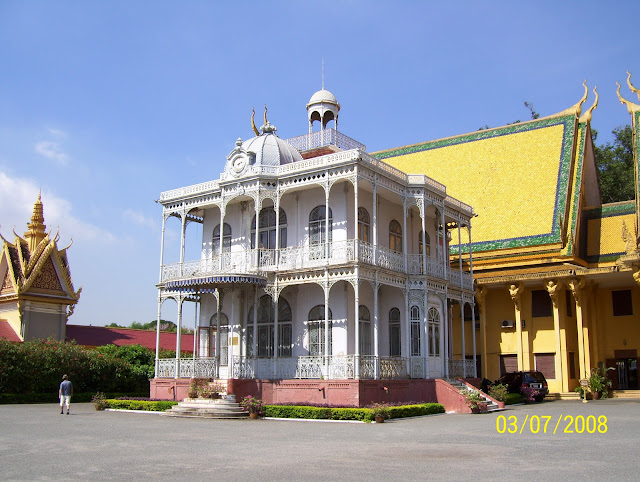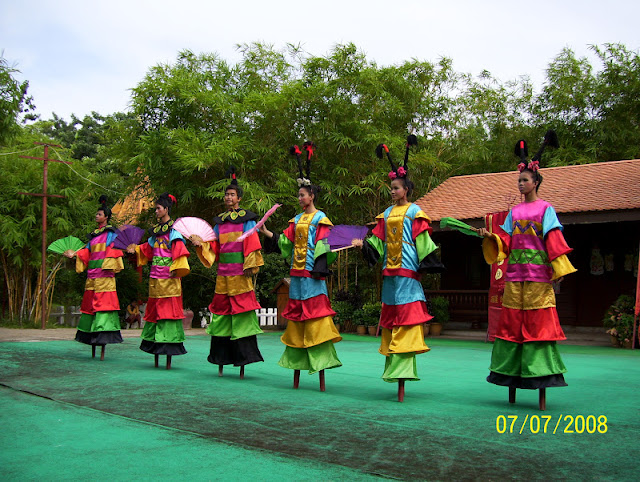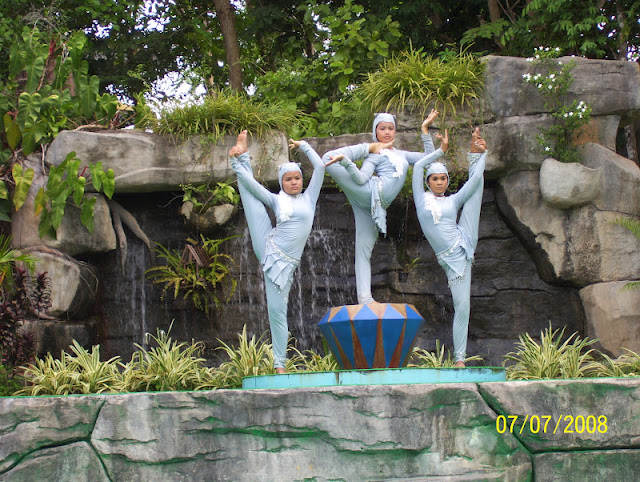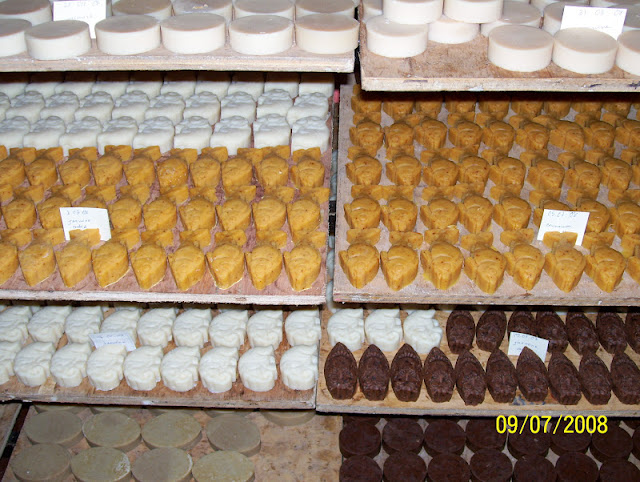10 Days to Phnom Penh & Siem Reap, Cambodia
2 - 12 Jul 2008
We booked our 5 days 4 nights two-to-go tour of Phnom Penh and Siem Reap with Malaysian Harmony & Tour S/B for RM730 per pax.
We extended our stay for another six nights in Siem Reap through the RCI exchange. The RCI exchange resort is the Prince D'Angkor Hotel & SPA
Day 1 (2nd July 2008)
Upon arrival we were welcomed by our local guide and checked into Castle Hotel. We were told to wait for another group of 5 to arrived before we go for our city tour.
Our first stop is the Independent Monument
We then visit the Naga Casino & Resort which are owned by Malaysians
Main Lobby of the casino
Girl selling lotus seeds for offering to the gods
Locals selling birds to be set free at the jetty where we board our Sunset Cruise. Locals offering prayers at the shrine on the right
We board this boat for our Sunset Cruise along Chaktomouk, The Four Face River
Sunset Cruise along The Four Face River
View of Naga Casino from the cruise boat
Cambodian Tuk Tuk (Local taxi)
After office traffic in Phnom Penh
Familiar scene in third country where lorry is filled to the brim
Day 2 (3rd July 2008)
View of the Royal Palace from Hotel Castle
Breakfast at the Hotel Castle roof top restaurant
View of Phnom Penh from Hotel Castle roof top restaurant
Morning market near Hotel Castle. After our breakfast while waiting for our local tour guide to pick us up we went for a walk at the market
Frogs on sale at the market. They are much smaller than the usual one we eat in Malaysia
Local vegetables
Fried Yam
Local vegetables
Baby craps and shell fish at the market
Cannon ball plant. The fruit looks like canon balls
The cannon ball flowers are beautiful
This is how the Canon ball fruit looks like
This building at the Royal Palace is constructed entirely from metal
Miniature Angkor Wat
Embryo eggs are a local delicacy
The Tuol Sleng Genocide Museum is a museum in Phnom Penh, the capital of Cambodia. The site is a former high school which was used as the notorious Security Prison 21 (S-21) by the Khmer Rouge communist regime from its rise to power in 1975 to its fall in 1979. Tuol Sleng means "Hill of the Poisonous Trees"..
This is one of the torture devices used by the Khmer Rouge on its own citizens. The prisoner is hung upside down and his head is lowered into the water jar to suffocate him to extract confession
Prisoners in smaller cells are shackled to the metal bed or the wall
The prisoner in mass cells are chained together at their ankles to prevent them form escaping
Our next stop is the Cheoung Ek Museum. Choeung Ek, the site of a former orchard and Chinese graveyard about 17 km south of Phnom Penh, Cambodia, is the best-known of the sites known as The Killing Fields, where the Khmer Rouge regime executed about 17,000 people between 1975 and 1979. Mass graves containing 8,895 bodies were discovered at Choeung Ek after the fall of the Khmer Rouge regime. Many of the dead were former political prisoners who were kept by the Khmer Rouge in their Tuol Sleng detention center.
The museum consists of 5,000 skulls and human remains
The bones that we excavated from the "Killing Fields"
Some of the mass graves that were excavated
Day 3 (4th July 2008)
This morning after breakfast the Phnom Penh guide sent us to the bus station for our journey to Siem Reap. The journey is about 6 hours and the bus driver drove none stop. Fortunately we did not have the urge to use the toilet. Upon arrival we waited about half an hour at the Siem Reap bus station for our local guide to pick us up. We went for our lunch before checking into the hotel.
About 4 pm we went for the sunset watching at Angkor Wat. We went to a temple called Phnom Bakheng (a short distance from the Angkor temple), and this place has been famous for a while now as the spot for sunset watching. To reach there we had to hike through jungle path.
The temple is located on a hill and the top of the temple is quite steep. We had to climb up the stairs at the background to reach the top.
Once you reach the top of the temple you will be rewarded with a fantastic view of all 360 degrees of the landscape just by walking around from one corner to another.
The sun is about to set
We managed to catch a rainbow during the sunset watching
At the top of the temple you'll get an unobstructed view of the sun as it goes down.
Once the sun set the whole place is darkened and we had to walk quickly to the waiting bus. It is quite a frightening experience when suddenly the whole sky is darkened
Our dinner tonight is in a restaurant with life performance by Cambodian dancers
Throughout the dinner we were entertained by the colorful and talented dancers
Day 4 (5th July 2008)
We stayed at the Kingdom Angkor Hotel along the way to Angkor Wat. After breakfast we waited for the bus to pick us up to explore Angkor Wat today.
Left side of the entrance to Angkor Thom. Angkor Thom was the last and most enduring capital city of the Khmer empire. It was established in the late twelfth century by king Jayavarman VII. It covers an area of 9 km², within which are located several monuments from earlier eras as well as those established by Jayavarman and his successors. At the centre of the city is Jayavarman's state temple, the Bayon, with the other major sites clustered around the Victory Square immediately to the north.
Right side of the entrance to Angkor Thom
South Gate entrance to Angkor Thom
Bayon Temple, the main temple in Angkor Thom
Two different types of stones are used in the construction of Angkor Wat. The one on the outside are of a harder variety
The stones are transported from another hill nearby to its present site. Strings are used to tine the stones through holes being driven through the slabs.
Day 5 (6th July 2008)
Today we visited the Tonle Sap Lake
For most of the year the lake is fairly small, around one meter deep and with an area of 2,700 square km. During the monsoon season, however, the Tonlé Sap river, which connects the lake with the Mekong river, reverses its flow. Water is pushed up from the Mekong into the lake, increasing its area to 16,000 square km and its depth to up to nine meters, flooding nearby fields and forests. The floodplain provides a great breeding ground for fish.
Young boy floating in a basin begging for money in Tonle Sap
View of Tonle Sap from our rest area. Notice the great expanse of the lake
Beside fishing, tourism is another major economic activity in Tonle Sap. You can see many of such boats transporting the tourists around
The daughter of the owner of the rest house having a python wrap round her
A church at the bank of Tonle Sap
Most of the villages move around with these small boats to conduct their daily activities
Some of the villages stay in these huts
After lunch we visited a silk factory. Here silk worms are fed the mulberry leaves
Mulberry tress are grown to feed the silk worms.
Silk worms cocoon are left to dry
Dried cocoons
Cocoons are boiled with dye and processed into treads for weaving into cloths
Processed silk threads
Silk cloth being woven
Deep dried crickets. Taste quite good!
After the tour ended we checked into the Prince D'Angkor for our extend stay. The room is spacious and facilities are good. We spent the rest of the day relaxing in the hotel and the surrounding area.
Entrance of Prince D'Angkor with its beautiful fountain. The hotel is centrally located in Siem Reap town and is walking distance to Siem Reap Market and other shopping area
After breakfast we took a walk along the street to the market. We stopped by this shopping centre that have a variety of Cambodian souvenirs and food stuff.
Roadside sign on the street showing the entrance to our hotel.
After lunch we decided to visit the Cambodian Cultural Village which is about 7km from our hotel. We took the motorbike tuk tuk from the hotel. It was a relaxing ride and we enjoyed the scenery along the way.
Cambodian Cultural Village covers a total area of 210,000 square meters. CCV presents miniature versions of important historical buildings and structures, together with local customs. There are eleven unique villages, representing the varied culture heritage of nineteen races. At each village are wood houses, carvings, soft skill in stone, traditional performances in the different style such as: Apsara Dancing, performances of ethnic minorities from Northeast of Cambodia, traditional wedding ceremony, Circus, Popular games, Peacock dancing, Acrobat, elephants shows, boxing, and more...
One of the giant paintings depicting the early Cambodian life
Dwelling place of one of the early tribe
Miniature Royal Palace
Miniature Central Market in Phnom Penh
Being carried by giant gorilla
Our first cultural show is a traditional Cambodian wedding where a Caucasian man was invited to be the groom
With some pretty Cambodian lasses while waiting for the show to start
Another love story scene.
This is how our tuk tuk looks like
Day 7 (8th July 2008)
We spent the morning relaxing in the hotel after breakfast and took some pictures of the hotel
The hotel boast a salt water swimming pool
Next we walk to a nearby handicraft centre so see silk painting and other art and craft
Statutes given a gold coating
Wood carving. The one in brown is a sample
Local delicacies at the market
Local vendor selling on a bicycle.
Day 8 (9th July 2008)
Bread being sold at roadside stall in Siem Reap town
We then visit a soap making factory. Here the workers are weaving colorful baskets for the soap.
Various types of soap. Looks like chocolates or cakes
Different scented soap cut into rectangulat shape
Back to the markets we saw small crabs being sold to the local staff manning the stores
We had lunch in a local Indian restaurant
We had dinner in the hotel tonight as we are tired of walking out again
Day 9 (10th July 2008)
Longans being grown in the hotel's compound
Roast bananas, a local delight
Lunch at a local restaurant. The coconut water was a real thirst quencher after our long walk
Election time in Cambodia. Party campaigning in Sime Reap. Much like Malaysia in the good old days
Our steam boat dinner at restaurant just outside the hotel
Enjoying our last leg massage in Siem Reap. During our week stay in Siem Reap we had a few rounds of traditional massage, oil massage and foot massage. Massage here is cheap (range from 5-8 USD) an hour and compatible with Thai Massage
Day 11 (12th July 2008)
Today is our last day in Siem Reap. After breakfast we just relax in our room and wait for the taxi to fetch us to the airport. Overall we had a fantastic trip to Cambodia.









































































































































































No comments:
Post a Comment